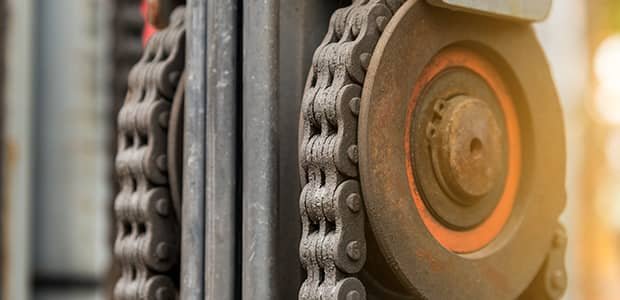Forklift chain maintenance is vital to ensuring the safety and efficiency of your warehouse operations. As a core component of the forklift, the chains endure significant wear and tear, which, if not addressed, can lead to serious safety risks, costly repairs, and operational downtime. Recognizing the signs of forklift chain wear and how to repair them is crucial for preventing accidents and prolonging your equipment’s lifespan.

At Upright Forklift Repair, we specialize in forklift chain repair, servicing, and spare parts in Houston and Humble, TX. Our experienced team helps businesses avoid unexpected breakdowns by addressing issues such as worn chains, ensuring your forklifts remain safe and reliable.
Understanding Forklift Chain Wear and Failure
Forklift chain wear occurs gradually due to constant stress during lifting and lowering operations. Several factors can accelerate chain wear, including harsh environmental conditions, overloading, and improper use. Mast chains and forklift chains are particularly prone to wearing out if they are not properly maintained or regularly inspected. When left unchecked, worn chains become a serious safety risk, increasing the likelihood of forklift malfunctions or accidents.

Additionally, failure to address chain wear early can result in expensive repairs or even complete equipment failure, disrupting your workflow. To avoid these consequences, regular inspections and maintenance of your chains are critical.
Common Signs of Forklift Chain Wear
Recognizing early signs of forklift chain wear is essential for preventing failure. Some of the most common indicators include:
- Plate edge chain wear: Visible thinning or wear along the edges of the chain plates.
- Cracked or broken links: Damage to individual chain links can lead to sudden failure.
- Enlarged chain holes: Excessive elongation can cause the chain to lose its structural integrity.
- Protruding or turned pins: Misaligned pins can create stress points, leading to uneven wear.
- Hydraulic pressure issues: Problems with your forklift’s hydraulics can contribute to premature wear in lift chains.
- Tight joints and premature wear: Stiff, inflexible chain joints are a clear sign that lubrication is lacking or that the chain is worn beyond repair.
Addressing these signs early can prevent further damage and reduce the risk of a forklift breakdown.
Causes and Modes of Forklift Chain Failure
Forklift chain failure can result from several factors, with wear and tear from daily use being the most common. Over time, the constant lifting and lowering of heavy loads lead to chain wear, which weakens the links and reduces the chain’s overall strength.

Environmental conditions such as exposure to dust, moisture, and extreme temperatures (e.g., cold storage) can accelerate wear, leading to worn chains and increasing the risk of failure.
Additionally, overloading the forklift or failing to perform routine maintenance further exacerbates wear, creating a significant safety risk. If not properly maintained, chains are more likely to snap or malfunction during operation, which could result in costly repairs or dangerous accidents.
Inspecting and Maintaining Forklift Chains
Routine inspections are essential to detect and prevent forklift chain wear before it becomes a critical issue. The first step is to visually inspect the chains for any signs of wear, such as cracked or broken links, elongated chain holes, or tight joints. Using a forklift chain wear gauge is highly recommended to measure chain elongation. If the chain wear exceeds 3%, it is time to replace the chain.

Additionally, check the inner mast rails and lift cylinders for signs of wear or damage. Look at the moving forks to ensure they aren’t dragging, as this could indicate chain tension problems. Regular lubrication is vital for preventing chain wear and ensuring smooth operation.
Finally, schedule professional inspections to ensure all components, including mast chains, are functioning properly, and address minor issues before they escalate into significant problems. Proper care and lubrication can extend the life of your forklift chains and enhance safety in the workplace.
Repairing and Replacing Forklift Chain Components
Knowing when to repair or replace forklift chains is crucial for maintaining safety and efficiency. Worn chains with minor damage, such as slightly cracked or broken links, may be repairable by replacing individual links or adjusting chain tension. However, if chains show significant wear, such as misaligned chain links or damage to the outside plates, it’s best to replace the entire chain. Use a chain gauge to measure elongation and ensure the new lift chain is the correct size.

Replacing a forklift chain involves several steps: First, remove the damaged chain and inspect mast rails and chain guides for wear. Next, install the new chain, ensuring it’s properly tensioned and aligned. A professional forklift technician plays a key role in this process, as improper installation or tensioning can lead to chain failure and accidents. At Upright Forklift Repair, our experts in Houston and Humble ensure your forklift chains are correctly installed and aligned, minimizing safety risks.
Best Practices for Forklift Chain Maintenance
Preventive maintenance is essential to avoid costly repairs and downtime. Regular inspections, proper lubrication, and addressing minor issues promptly will help prevent larger problems. Keeping forklift chains properly maintained increases productivity, extends their lifespan, and reduces the risk of failure in challenging environments like cold storage.
Following expert guidelines ensures your equipment runs smoothly, and maintaining mast chains regularly can help prevent safety risks and expensive breakdowns.
Call to Action
Regular forklift chain maintenance is essential for safety, operational efficiency, and extending forklift lifespan. Upright Forklift Repair in Houston and Humble offers expert services, from inspections to repairs and replacements, ensuring your chains stay in top condition. Don’t wait for minor issues to become major safety risks—contact us today to address any signs of forklift chain wear and keep your equipment running smoothly, while maximizing your forklift lifespan.
